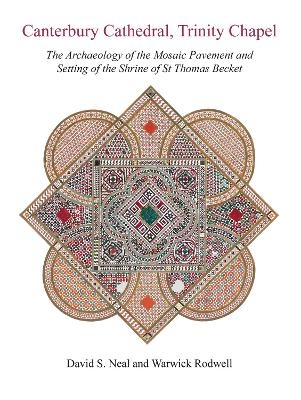
Canterbury Cathedral, Trinity Chapel
Oxbow Books (Verlag)
978-1-78925-841-7 (ISBN)
Canterbury Cathedral possesses a unique marble mosaic pavement, dating from the early 12th century, which has long intrigued scholars and been the subject of speculation and debate. It forms part of the floor of the Trinity chapel, adjacent to the site where the shrine of St Thomas Becket stood, prior to the Reformation. Since the mosaic is older than the chapel itself and partly destroyed a pavement of figurative roundels, laid c.1215, it must have been moved here from elsewhere in the cathedral. This volume explores the history and archaeology of the Trinity chapel, the pavement and the physical remains of the cult of Becket, based largely on hitherto unrecorded and unpublished evidence.
In the early 12th century, Archbishop Anselm rebuilt the eastern arm of the cathedral, introducing architectural elements from his native Italy, and these included a magnificent mosaic pavement, composed of the most expensive marbles, which lay in front of the high altar. In 1170, Archbishop Becket was murdered in the cathedral, and his body rested overnight on the pavement before being buried in the crypt. Thomas was immediately revered as a martyr, and in 1173 was canonised by the pope; a simple shrine was erected over his tomb. In the following year, a fire (arson) destroyed the eastern arm of the cathedral, precipitating the construction of the present Trinity and Corona chapels, wherein St Thomas’s remains were enshrined.
After decades of delay and political strife, the enshrinement took place in 1220, in the presence of Henry III. The shrine comprised a great marble table, supported on six clusters of columns. On top of the table was a marble sarcophagus containing the saint’s body in an iron-bound timber coffin, over which stood the sumptuous feretory, a gabled timber ‘roof’, plated with sheets of gold and adorned with jewels. East of the shrine lies the small Corona chapel in which a fragment of Becket’s skull was separately encased in a ‘head-shrine’, and to the west a large area was paved with forty-eight figurative stone roundels, created by French artisans. All around, stained-glass windows display the early miracles of Becket.
The layout of the Trinity chapel underwent transmutations, first around 1230, when the mosaic pavement was taken up from the old presbytery, reduced in size and relaid in front of Becket’s shrine, where is it today. Second, the chapel was reordered in c. 1290, when the podium carrying the shrine was enlarged and the paving around it reconfigured. Medieval tombs were now being installed in the chapels, including those of the Black Prince and Henry IV. The end came in 1538, when Henry VIII ordered the thorough destruction of Becket’s shrines, but a great deal of archaeological evidence remained in the floors, walls and a few surviving fragments of the shrines, all now recorded and discussed in this beautifully illustrated volume for the first time.
Dr David S. Neal, NDD, D.Litt, FSA, trained in graphic design and was head of archaeological illustration of the Ancient Monuments Inspectorate, and later became Senior Archaeologist, English Heritage. He has many years of experience in the study, illustration and publication of mosaic pavements, and is joint author of the major work on the mosaic pavements in Roman Britain, Roman Mosaics of Britain (2002–2010). In 2012 he joined forces with Warwick Rodwell, to illustrate and analyze the assemblage of medieval cosmatesque mosaics in Westminster Abbey, in which they published The Cosmatesque Mosaics of Westminster Abbey: The Pavements and Royal Tombs (Oxbow, 2019). Professor Warwick Rodwell, OBE, D.Phil, D.Litt, FSA, is Consultant Archaeologist to Westminster Abbey and formerly Visiting Professor in Archaeology at the University of Reading. He has written or edited several volumes on Westminster Abbey. He is also author of volumes on Wells Cathedral, Dorchester Abbey and The Archaeology of Churches (2012).
Foreword
Preface
Acknowledgements
Summary
Introduction
1. The Trinity and Corona chapels in context
2. The antiquarian record
Part 1: The Mosaic and inlaid-roundel pavements
3. The Romanesque mosaic pavement in bay 1
4. History and interpretation of the mosaic pavement
5. The pavement of figurative stone roundels in bay 1
6. Interventions in the roundel pavement: 13th to 20th century
Part 2: The Trinity chapel and shrines of St Thomas of Canterbury
7. Aspects of the archaeology of the Trinity and Corona chapels
8. The shrine pavement in bays 2 and 3
9. St Thomas’s shrine-tombs and their setting
10. The Corona chapel (‘Becket’s Crown’)
11. Synthesis and discussion
12. The petrology of the tesserae and paving by Kevin Hayward
13. Appendices
Notes to chapters
Abbreviations
Bibliography
Index
| Erscheinungsdatum | 26.09.2022 |
|---|---|
| Zusatzinfo | Colour |
| Verlagsort | Oxford |
| Sprache | englisch |
| Maße | 240 x 305 mm |
| Themenwelt | Geisteswissenschaften ► Geschichte ► Regional- / Ländergeschichte |
| Technik ► Architektur | |
| ISBN-10 | 1-78925-841-3 / 1789258413 |
| ISBN-13 | 978-1-78925-841-7 / 9781789258417 |
| Zustand | Neuware |
| Haben Sie eine Frage zum Produkt? |
aus dem Bereich


